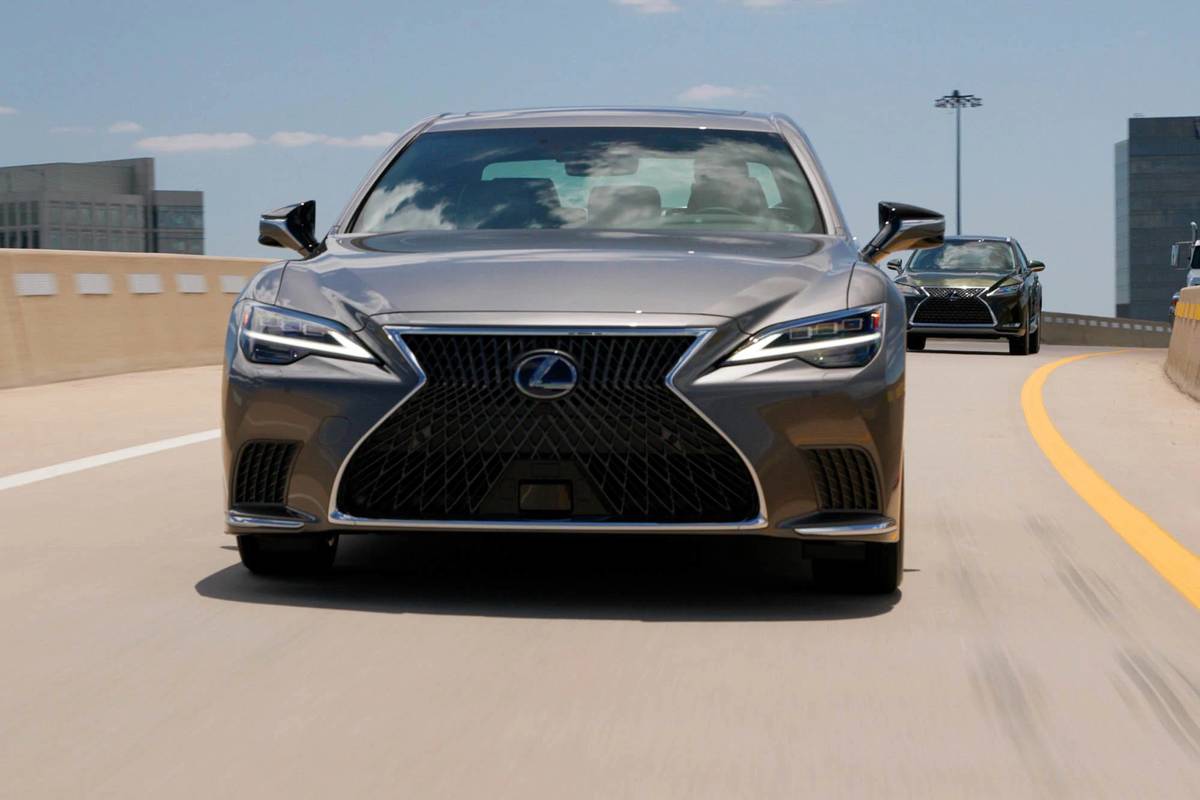The 2022 Lexus LS 500h Has a Hands-Free Driving System; We Try It


I’m not gonna lie, self-driving cars freak me out a little bit. It takes a shift in expectations and perceptions to push a button, sit back and let a 3-ton automobile guide itself down the highway at 75 mph while you just sit with your hands in your lap. First of all, we need to reiterate that no car on the market today has an actual fully autonomous self-driving system, not GM’s Super Cruise, not Tesla’s Autopilot. All these systems are driver-assist systems meant to be used by drivers who are still present, conscious and cognizant of the vehicle’s operation and environment.
I’ve sampled such driver-assist systems in a number of different automakers’ offerings, from Mercedes-Benz to GM, and now I’ve sampled the latest partial hands-free system from Toyota in the form of Lexus Teammate, built into prototypes of the Lexus LS 500h luxury flagship sedan and demonstrated recently at Toyota’s North American headquarters in Plano, Texas.
Related: What’s New From Lexus for 2021?

What Is Lexus Teammate?
Lexus Teammate is the latest iteration of years of development work, sensor fusion, software creation and human-machine interaction studies to create a Level 2 semi-autonomous system: meaning it has the ability to accelerate, stop and steer the vehicle, but it still very much requires a human monitoring its actions at all times. How much monitoring? More than one might expect.
Lexus’ Teammate has two functions: Advanced Drive and Advanced Park. I sampled Advanced Drive on the highways of suburban Dallas. It will be available in the all-wheel-drive 2022 Lexus LS 500h later this fall. It’s meant as a system that augments the driver for additional safety and to ostensibly reduce fatigue; Lexus is not billing it as a self-driving system, but a driving assistant. Through a combination of sensors and high-definition maps downloaded from a central server, it allows varying degrees of semi-autonomous, hands-free cruise control. But it’s more than just advanced cruise control, because it has a predictive feature that analyzes the route and traffic, and can do things like decide to overtake an adjacent vehicle when changing lanes, or slow the vehicle for an off-ramp or connecting ramp between highways. It can also exit the highway entirely, and it provides the driver with an up to 6-mile plan of what it intends to do. This is useful in warning drivers when they’ll be required to fully take over piloting the vehicle, but in my experience with the Teammate system, the driver never truly gives up control of the vehicle. Let me explain.

How Is It Different From Super Cruise?
The majority of my experience with semi-autonomous driver-assist systems comes in the form of GM’s latest Super Cruise. GM’s Super Cruise was the latest version I’ve been in, having driven it in a new 2021 Cadillac Escalade equipped with the new software that also allows hands-free lane changes. Where Teammate seems to differ most from other systems is in the level of involvement and constant attention required from the driver. For instance, Super Cruise will work very hard to maintain a hands-off approach, while Teammate will insist you put a hand on the wheel at seemingly random times for no obvious reason. It may steer autonomously for a few miles, insist you put a hand on the wheel for a few minutes, and then go back to not requiring you to touch the wheel, despite the conditions and road surface not noticeably changing.
If you want to engage a lane change, Super Cruise has you engage the signal and then it scans to make sure the way is clear in the adjacent lane before guiding the car over there itself. Teammate requires extra steps: The driver must physically check mirrors or turn their head before executing the lane change; it has an infrared camera pointed at the driver’s face the whole time to make sure the driver does one of those things or it won’t engage the automatic lane change. It also may decide not to allow the lane change you’ve requested if it doesn’t like where you want to do it — maybe there’s a highway on-ramp coming up or you’ve just passed one, or for some other reason not made clear to you. Super Cruise makes no such judgments because it trusts you’re already looking to see if the way is clear and its scan merely confirms the environment, and it moves the vehicle as you’ve requested. In a nutshell, Lexus Teammate is fussier, seemingly less trusting of the driver, and requires a significantly greater level of driver participation and monitoring in what is supposed to be a Level 2 semi-autonomous system.

While Teammate requires the driver to be a much more active participant in the experience, there’s one area where Teammate stands out compared to Super Cruise: Teammate ties into the car’s navigation system, so you can input your destination and the car knows essentially how to drive you there. Super Cruise doesn’t match this yet. It’s not a “fire and forget” kind of system (yet); it requires you to be an active participant as described above, but the system knows where you’re going, and the predictive nature of Teammate is employed to change highways on connecting ramps by selecting the lanes you need to be in to exit a highway at the exit you need, automatically moving the car to them (conditions permitting). It can pick speeds for those ramps, and it can even exit the highway and send you through a tollbooth. Teammate cuts out once you’ve left the highway, but it also warns you exactly when you’ll need to take over — just make sure you let it know you have taken over by touching the brake or accelerator. Touching the wheel or steering yourself doesn’t do that, annoyingly.

What Does It Do Better Than Super Cruise?
That’s a premature question, for the moment. The version I drove was not the final production software, so there might be more refinement before Teammate hits the streets later this year. In some ways, GM’s Super Cruise is better — it seems to maintain more autonomous control over the vehicle for longer periods of time and in more conditions than Lexus Teammate. Teammate requires a lot more operator attention and involvement, to the point that I begin to question its purpose. If I’m expected to be doing everything I would normally be doing while driving a car (turning my head to check blind spots, keeping my hands on the wheel), what’s the point of engaging a semi-autonomous drive system? I may as well just drive the car myself.
But the Lexus system’s ability to tie into the navigation system and control more aspects of the car’s operation to guide you to that destination gives it a tasty advantage in that area. But until then, the trade-offs of the aggressive level of monitoring and the highly conservative ethos of where and when the system will properly engage have me leaning toward Super Cruise still being the best system of the two.
Related Video:
More From Cars.com:
- Which Cars Have Self-Driving Features for 2021?
- Updated 2021 Lexus IS Gets Updated Pricing, Starts at $40,025
- 2021 Lexus IS: ‘I’ Is for Improved, ‘S’ is for Sort Of
- 2021 Lexus ES Offers AWD, Smaller Engine and Black Line Special Edition
- 2021 Lexus IS 350 Review: Refocused but Not Rejuvenated
Cars.com’s Editorial department is your source for automotive news and reviews. In line with Cars.com’s long-standing ethics policy, editors and reviewers don’t accept gifts or free trips from automakers. The Editorial department is independent of Cars.com’s advertising, sales and sponsored content departments.

Detroit Bureau Chief Aaron Bragman has had over 25 years of experience in the auto industry as a journalist, analyst, purchasing agent and program manager. Bragman grew up around his father’s classic Triumph sports cars (which were all sold and gone when he turned 16, much to his frustration) and comes from a Detroit family where cars put food on tables as much as smiles on faces. Today, he’s a member of the Automotive Press Association and the Midwest Automotive Media Association. His pronouns are he/him, but his adjectives are fat/sassy.
Featured stories




